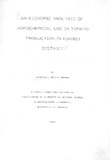| dc.description.abstract | The purpose of this study was to analyze agrochemicals use in pest-disease control in Kiambu district. The broad objective was to study the use and the economics of pesticides in Kiambu district. The specific objectives involved description and determination of profitability of pesticides, description of the pesticide use and the determination of the factors that influence pesticide use in the area of study.
Using a structured guestionnaire, data was collected from 89 small scale tomato growers through interviews. The study was done on 1991 short rains tomato crop. The analysis was mainly done through a Cobb-Douglas production Function and cross tabulations. Two hypothesis were conducted to test whether a statistical difference existed between the marginal value product and the marginal factor cost of insecticides and fungicides respectively.
Results indicated that the marginal value product of insecticides and fungicides were statistically different from the respective marginal factor costs. The difference can be attributed to some extent, to the fact that only 14% of the farmer? used insecticides within the recommendations and that a proportion of 45% of the farmers applied doses of insecticides which were not effective, thereby getting no increment in yield from their Pesticide application. However, 40%, did not deviate significantly from recommendations. Similarly, only 22% of farmers used
(X\v)
Fungicides as recommended, fifty percent used fungicides significantly far above the recommendations. The latter explains the statistical difference in marginal value product and marginal factor cost.
Evaluation of farmers response to the constraining factors against adeguate pest/disease control revealed that inability to afford pesticides and lack of access to information on pest/disease control ranked high among the constraints mentioned. From the outcome of this study, it was concluded that future increase in returns to pesticides would come from the ability to devise and implement policies aimed at reducing underuse and overuse of pesticides. Curbing the sale of unpacked or repacked pesticides by middlemen through law enforcement would ensure that the effectiveness of the pesticides is maintained and proper application would therefore increase the returns to pesticides. The rampant deviation of pesticide use from the recommendations and the poor returns from pesticide use can be achieved through a rigorous extension services to fill the farmers knowledge gap. | en_US |



